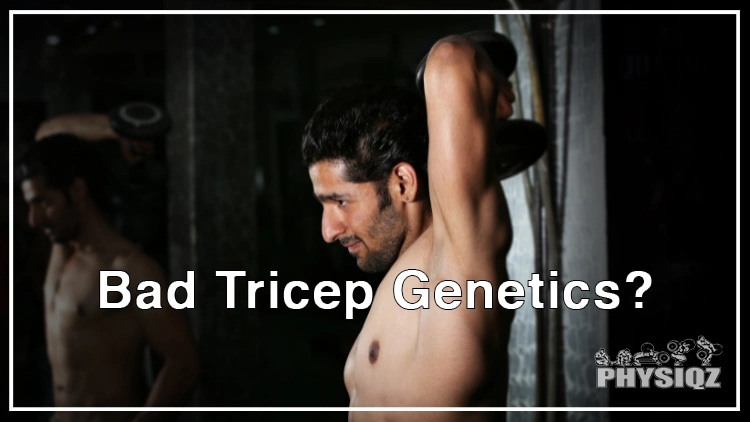
Sometimes bad tricep genetics vs good can be seen by looking at where the insertions are in relation to the elbow, proportions in comparison to the bicep, and asymmetries between the left and right tris.1
But if you can’t tell, these examples with pictures will help you be able to tell if anyone has fair tricep genetics. And if you’re judging yourself, take the long vs short tricep insertion test to find out in a more empirical way.
Note, even if you have less favorable tricep genetics don’t feel like that’s a curse because even some of the most prolific bodybuilders had so-so tricep genetics and they were able to overcome it by using many of the same concepts discussed below.
An Overview of What Tricep Insertions Are & Their Effect on Tricep Appearance
Most people don’t think much about the different tricep insertions and their effect on how the muscle looks; most people simply worry about if they have a powerlifter physique vs bodybuilder physique.
Regardless, the triceps brachii has three main heads: the long head, medial head, and lateral head. Each of these heads has a different origin point (where it attaches to the bone), but they all insert at the same point on the ulna (one of the bones in the forearm).
The long head of the triceps is the largest and most visible of the three heads. It’s responsible for a large portion of the mass and thickness of the triceps muscle. The long head originates from above the socket of the shoulder blade and runs down the back of the arm.
The medial head is much smaller than the long head and it originates from the humerus (the bone in the upper arm). The lateral head is also small and it originates from the lateral (outside) edge of the humerus.
The long head is the most important head for creating that “horseshoe” tricep look. If a bodybuilder or casual lifter wants to maximize the size and thickness of their triceps, that individual needs to focus on exercises that target the long head.
The medial and lateral heads are still important for creating overall mass, but they’re not as effective for shaping the muscle.
Long vs Short Triceps (Low Tricep Insertion vs High Tricep Insertion): Which is Better?
There’s a lot of debate on whether long or short triceps are better. Some people say that long triceps are more aesthetically pleasing because they give the arm a more ” sweeping” look. Others say that short triceps are better because they add more mass to the upper arms.
The truth is, it doesn’t really matter which is better. Whichever genetic tricep insertion a person is born with – whether it is a low insertion, a high tricep insertion, or somewhere in between – there is no way to change it.
In general, if someone who wants to maximize the size of the triceps they should focus on exercises that target the long head of the muscle since it is responsible for most of the size and strength. Research shows that training the triceps brachii itself will significantly increase its overall ability for it to produce force and grow in the long term.2
However, if a person is happy with the size of their triceps and they just want to add some definition, then any exercise that targets the triceps will do since it’s impossible to isolate one head in particular, although you can switch the emphasis by using different grips and arm positioning such as supinated, pronated, arms over head, and arms by your side.
All in all, to create a “horseshoe” look, then they should focus on a variety of exercises to “target” all three heads of the muscle. These four exercises will help to add mass to the triceps and create that desired shape by targeting all three heads of the triceps:
Close-Grip Bench Press
The close grip bench press primarily targets the medial and the lateral head of the tricep, helping to build a bit more density to the arm overall. This is a solid compound movement because it also requires for a person to use their chest to do the movement.
At first glance, it appears unconventional to consider a chest movement beneficial for tricep development.
Regardless of what the ‘main’ muscle in a movement is, when smaller muscles are used in compound movements, there is a much greater capacity for weight to be moved.
So if a person can lift 135 pounds in a close-grip bench press, that will offer a lot more resistance to the tricep than a 40-pound rope pushdown on the cable machine.
Keep in mind that the numbers aren’t directly transferrable – a person can’t say their triceps can ‘lift’ 135 pounds just because they did a close grip bench at that weight, but internally, they can know that they’ve lifted quite heavy with their triceps before. This movement is overall fantastic for developing strength helping to harden muscles in both the arms and chest.
Cable Triceps Pushdowns
Triceps pushdowns are a great isolation movement for targeting the long and lateral head of the tricep and are frequently found in a beginner hypertrophy program. This tricep head most often contributes to a very dense, beefy arm. This exercise can be done with a rope, a bar, or a band, and it can be done with a variety of different grips.
Considering the fact that EMG analysis shows the cable pushdown is significantly more effective at activating the long and lateral heads of the tricep, this is a staple movement.
The key to making this exercise effective is to keep the elbows close to the body and to focus on using the triceps to do the work. This can be a difficult exercise for people because they often use their shoulders or their chest to push the weight down, rather than using their triceps.
When done correctly, this exercise will help to build definition and shape in the triceps. It can also be used as a finishing exercise to help ‘pump up’ the muscle and get some blood flowing to the area.
Cable or Dumbbell Overhead Triceps Extensions
The overhead triceps extension is another great exercise for targeting all three heads of the triceps and they put the focus on the long head since the arm is more overhead or a raised shoulder position. This exercise can be done with a dumbbell, a barbell, or a band, and it can be done with a variety of different grips.
To make this exercise work best, keep the elbows close to the head and focus on using the triceps to do the work. This can be a difficult exercise for people because they often use their shoulders or their chest to push the weight up, rather than using their triceps.
Studies have shown that specifically for the overhead tricep extension, the eccentric phase has lower muscular activity than the concentric phase, so prioritizing a strong contraction on the way up is important.3
Dumbbell Kickbacks
While these don’t generate much power, one role of the long head is to push the arm behind the body in addition to extension so adding these in as a pre-exhaust or post-exhaust set can help with maximum contraction and mind muscle connection.
To sum it up, there is no “best” tricep insertion; while there are many people that prefer a low tricep insertion, one that inserts further towards the elbow on the arm, some people also prefer a high tricep insertion because they feel that they can build an overall thicker arm (at least where the tricep sits).
Regardless, for those wondering how to add mass to their triceps, the majority of the focus should be on exercises that target all three heads of the muscle. Using some of the exercises mentioned above, which will also be discussed further below, provide ample stimulus for all three heads of the tricep.
This is primarily because for those who want to add definition and shape to their triceps, the focus should be on exercises that target the individual heads of the muscle.
Ultimately, the ability for a person to grow their triceps relies on them and their choices in the gym. Just remember that different exercises will target different areas of the muscle, so it’s important to choose the right exercises based on what a person wants to prioritize when it comes to their triceps.
All of that being said, it is time to take a look at what some people consider ‘good’ genetics and what people consider ‘bad’ genetics so that a better understanding of what differing tricep genetics actually look like.
Good vs Bad Tricep Genetics: Identifying Their Characteristics
There is no “ideal” triceps insertion, as each person’s genetics will dictate where their triceps insert.
However, there are some generalizations that can be made about good and bad arm genetics.
A High Tricep Insertion Is Usually Considered Bad Tricep Genetics
A high tricep insertion means that the tricep muscle inserts higher up on the humerus (upper arm bone) than normal. This means that while the overall tricep will have a higher peak than someone with a low tricep insertion, it will look significantly less ‘full’ than with a low tricep insertion.
To make things even more clear, take a look at this picture of Shariar Kamali, also known as King Kamali, an ex-IFBB professional bodybuilder.
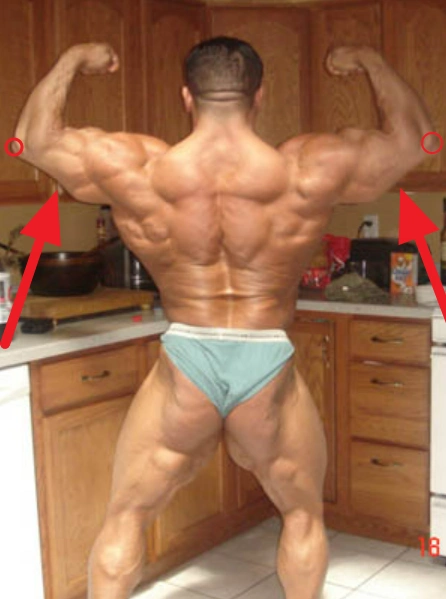
Take note of where his triceps end (where the red arrows point to) and the tips of his elbows (in red circles). Source: @kingkamali on Instagram4
Look at the elbows – for someone with a high tricep insertion, their tricep ‘drops’ further away from the elbow, closer to the shoulder. It is clear to see here that this is the case for Kamali – his tricep does not actually drop until roughly halfway up the length of his arm.
Now on the other side, look at Sergio Olvia’s insertions and how much closer they are to his elbow.
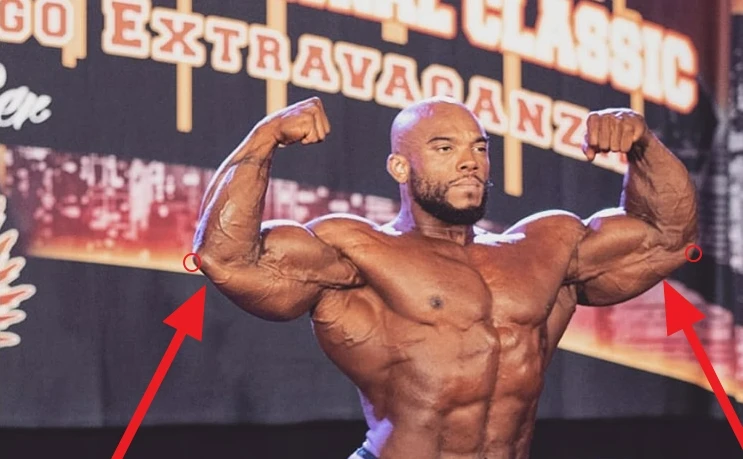
Notice how his tricep insertions are closer to his elbows, as indicated by the red arrows. Source: sergioolivajr on Instagram5
This is the main reason many people consider a high tricep insertion to be ‘bad tricep genetics’. Due to the fact that the total amount of muscle that can be shown or gained is limited by genetics, most people conclude that their triceps or even arms will never be big due to their short triceps.
But, as mentioned above, forgetting about ‘good’ or ‘bad’ tricep genetics is important; all a person can do is train as hard as they can, get ample recovery, and build the muscle that their body allows for.
Kamali did, and he still looks quite jacked.
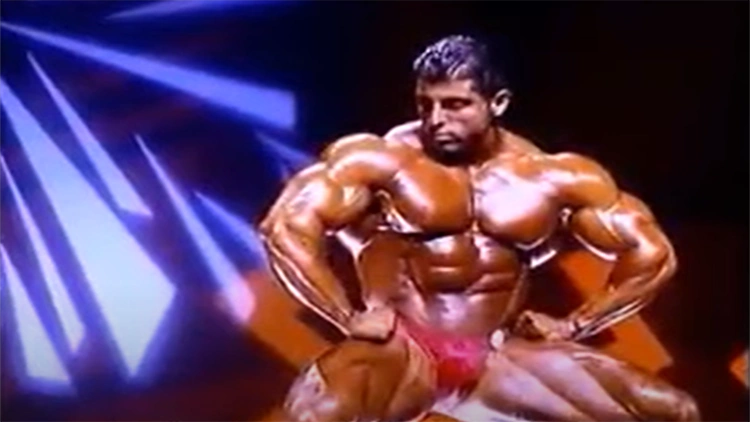
Regardless of genetics, it’s evident how impressive Kamali’s overall physique is due to his hard work and determination. Source: Michael Diamond Bodybuilding on Youtube6
Regardless, it is time to move on to see what long triceps, or low insertion triceps, look like.
A Low Tricep Insertion Is Usually Considered Good Tricep Genetics
Take a look at this picture to understand the difference between a short and a long tricep.
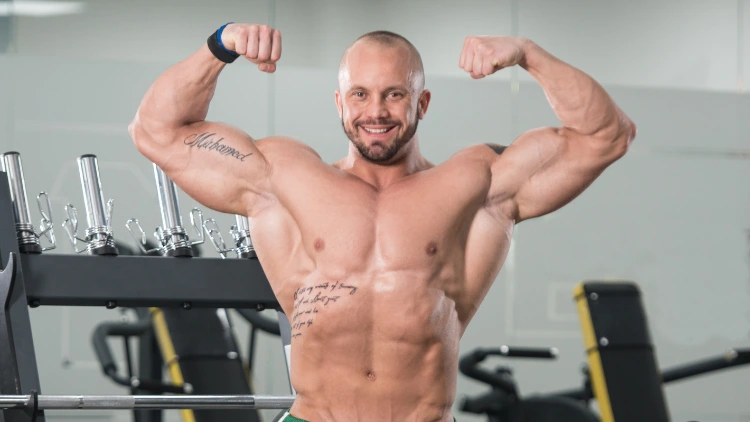
Again, note where his tricep ends and in relation to the tip of his elbow. Source: Ibrakovic via Canva.com7
Compare this picture to the previous one of Kamali; for this man, the triceps are well-rounded and follow a curve between the shoulder joint and the elbow. Since there is no visible insertion point where the curve suddenly cuts off, this means he has a lower tricep insertion, offering a fuller look than one where the curve suddenly stops.
What About the Proportionality of Tricep Head Sizes?
There is some discussion on the internet debating whether or not there is a correlation between less favorable tricep genetics and poorly sized tricep heads. More specifically, lifters are curious if there is a correlation between disproportionately sized tricep heads, where one head is larger than the other; for example, if the long head is abnormally larger than the other two heads.
In reality, there is not sufficient evidence to suggest that this actually occurs; since no research has been conducted, and it is quite a difficult claim to prove, it can safely be assumed that worrying about how proportional one’s tricep heads are to one another is not worth the effort.
Are There Really Good & Bad Tricep Genetics?
In general, many people believe that good tricep genetics mean that a person has a low tricep insertion, or has a long tricep since the fuller look is something that many people purport is the gold standard for the top bodybuilders in the world.
On the other side of the coin, the vast majority of people who lift weights do not plan on becoming an IFBB professional so the differences in bad vs good tricep genetics is negligible for most people.
Ultimately, the main takeaway from this article should be that there are different types of tricep insertions that alter how the triceps look overall, but because it is impossible to change the genetic insertion location, people with poor tricep genetics should consider blasting them just a little more each session to bring them up.
Plus, triceps recovery quickly and the exercises aren’t very taxing so there’s no harm in hitting them frequently.
Use the Triceps Insertion Test To See If Your Tricep Genetics Are Good or Bad
We know what bad tricep insertions look like now and you can always just gauge it by eye with fair accuracy, but to get a better idea if you have bad bicep genetics, try the following steps.
Step 1: Straighten your right arm.
Step 2: With your left arm, take three fingers (pointer, middle and ring fingers) and put them on the backside of your arm, just underneath the long head and with your pointer finger at the end of your elbow. Almost as if you were doing a single arm hug with just your left hand and placing it near your elbow.
If your long head tricep insertion point is more than 3 fingers from your elbow, then unfortunately, you don’t have great tricep genetics. You can check the media head too but this isn’t nearly as important since the long head is responsible for most of the size, especially in the front double bi pose.
How To Overcome Bad Bodybuilding Genetics When it Comes to Triceps
Even if a person has what some might call “bad” tricep genetics, that doesn’t mean they can’t still build a set of huge arms.
What it takes is the willingness to put in the work, utilize the right exercises and techniques, and be consistent with training – this same principle applies to working out while having bad chest genetics, bad ab genetics, and/or bad shoulder genetics.
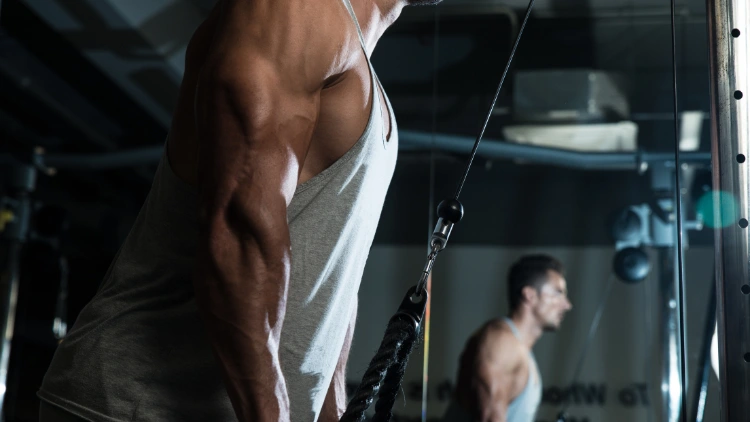
Source: Ibrakovic via Canva.com8
Progressively Overload: This essentially means to increase the amount of sets, reps and/or weight overtime. So if you’ve been doing tricep push downs with 40lbs for weeks not, consider adding 5lbs. Of course, this is an oversimplification but it’s a surefire way to see progress without getting too technical.
Use Compound Movements: Compound exercises are multi-joint movements that involve several muscle groups and they give you the most bang for you buck. So things like bench press, overhead press, dubbell presses will all work your triceps in a fashion that isolation exercises will never come close to. Note, isolation exercises have their place, but do them after the lifts where you can move the most weight.
Try Different Modalities & Intensity Techniques: Things like giant sets, drop sets, partial reps, and supersets can all exhaust your triceps and really help feel the burn.
Focus on Mind Muscle Connection: Speaking of burn, if you’re doing tricep exercises without truly feeling a burn, you may want to do a phase or mesocycle where that’s the primary focus. In general sets of 1-10 reps feels like tension, 10-20 reps you can feel some burn, and 20-30 reps your arms should be on fire.
Experiment With Different Rep Ranges: The most important part of training for hypertrophy for the triceps is ample stress on the muscle. An analysis of most modern research shows that to maximize muscle growth, a person should do 3-6 sets of 6-12 repetitions with short rest intervals of 60 seconds to maximize growth, increasing volume as time goes on.9
However, this is an overgeneralization and each muscle group is different. Therefore, we suggest training in a variety of rep ranges, primarily 1-10, 10-20, and 20-30.
Use a Variety of Grips: As mentioned, to get that horseshoe look, it’s best to workout with various grips to emphasize different heads of the tricep. Don’t be overly concerned with his though because you can’t isolate one head entirely. Instead, do some exercise over hand, some underhand, others with your arms next to you, a few with your arms overhead, and throw in tricep kick backs too.
Get Closer* to Failure With RiR and RPE: When we say RPE in lifting, or RiR, we mean Rating of Perceived Exertion Explained and RiR is Reps in Reserve. While slightly different, what these both mean is how close to failure did you get.
So an RiR of 2 means you did a set of say 10 reps, but you feel like you could’ve done 2 more reps. Or you left 2 reps in reserve. On the other side, that would be an RPE of 8 since it was an 8 out of 10 difficulty wise.
Most growth is seen with an RiR of 1-3 and going to failure isn’t advisable since it causes excessive fatigue.
Get Enough Volume: Essentially, if you’re not doing enough sets or working out with enough intensity then your triceps will never grow. For a full explanation, check out this video and if you prefer reading, here’s a full tricep training guide with tips from Dr. Mike.
This article was written to show that there is no such thing as bad tricep genetics and that with the right exercises and training split, anyone can overcome any supposed hurdle through hard work, dedication, and proper rest.
References
1pixelfusion3d. Canva, 20 April 2019. Accessed 13 April 2023. <https://www.canva.com/photos/MAEJKQKGhHE-men-doing-triceps-exercising/>
2Sugisaki, N., Wakahara, T., & Murata, K. (2015). Influence of muscle hypertrophy on the moment arm of the triceps brachii muscle. Journal of Applied Biomechanics, 31(2), 111-6. <https://pubmed.ncbi.nlm.nih.gov/25411895/>
3Alves, D., Matta, T., & Oliveira, L. (2018). Effect of shoulder position on triceps brachii heads activity in dumbbell elbow extension exercises. Journal of Sports Medicine and Physical Fitness, 58(9), 1247-1252. <https://pubmed.ncbi.nlm.nih.gov/28677940/>
4Shahriar King Kamali (@kingkamali) • Instagram photos and videos.” Instagram. Accessed 5 April 2023. <https://www.instagram.com/kingkamali/>
5SERGIO OLIVA JR (@sergioolivajr) • Instagram photos and videos.” Instagram. Accessed 5 April 2023. <https://www.instagram.com/sergioolivajr/>
6“Posing-King Kamali.” Youtube, 16 November 2008. Accessed 5 April 2023. <https://www.youtube.com/watch?v=kfAnSVMk9dc>
7Ibrakovic. “Bodybuilder Flexing Muscles.” Canva. Accessed 5 April 2023. <https://www.canva.com/photos/MADyXIOEZVI-bodybuilder-flexing-muscles/>
8Ibrakovic. “Triceps Pulldown Workout.” Canva. Accessed 5 April 2023. <https://www.canva.com/photos/MAC__YQd1Z4-triceps-pulldown-workout/>
9Krzysztofik, M., Wilk, M., Wojdala, G., & Golas, A. (2019). Maximizing Muscle Hypertrophy: A Systematic Review of Advanced Resistance Training Techniques and Methods. International Journal of Environmental Research and Public Health, 16(24), 4897. <https://www.ncbi.nlm.nih.gov/pmc/articles/PMC6950543/>